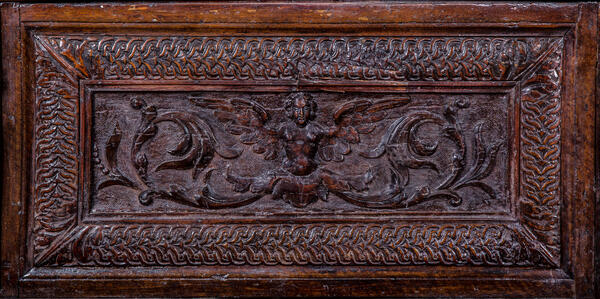In the exposition, next to an impressive wardrobe, you do not immediately notice a small chest on curly “paws” with carved decor, a smooth lid and heavy iron handles. In shape and style of decorations, it resembles a small architectural structure. At the end of the twentieth century, the restorer and mahogany worker Evgeny Semenovich Trenin disassembled the chest and found a coin immured in its wall. The exhibit, which had been “hiding” for so many years, was recorded in the book of receipts, and the mystery gave no peace. The chest is one of the first receipts of the museum in 1918, it belonged to Countess Praskovya Sergeevna Uvarova.
The soldo found is a small change coin that was minted in the Republic of Venice in the XVIII century under Doge Alvise IV Mocenigo (1763-1778). Its one side has a winged lion with a halo — the symbol of St. Mark, the patron saint of Venice. In front of him is the figure of the doge with the standard of the republic. The back depicts the blessing Lord. Soldo confirms that the chest was made no later than the same century. After all, Italian, more often Venetian, furniture makers, whose specialty was wedding chests, used to pawn a coin “for the happiness of the young.” According to the centuries-old tradition, the groom gave the bride a chest. Such versatile furniture served both for storing things, for interior decoration, and for sitting.
This chest the Uvarovs couple — Count Alexey Sergeevich and his young wife Praskovya Sergeevna, apparently, brought from their honeymoon. It was probably acquired in Venice, about which in her memoirs “The Past. Happy days of yore, ” the Countess wrote: “There seems to be no picture more majestic and beautiful than the view of Venice when you face it from the sea and make your way through the lagoons: here to the left is an island with a church S. Giorgio Maggiore; in front of us is the square S. Marco, bordered by majestic marble buildings and palaces, and then the beginning of the Canale Grande. Something fabulous majestic, belonging to Venice alone, emanates from this picture…”. The couple’s family life began with an unusually long two-year honeymoon abroad: country by country, museum by museum, libraries, archives, excavations, acquisitions of works of art. They returned to Russia in 1861 with impressions, with two children born, with scientific works, with new collections. Hidden in a wonderful wedding chest, the “lucky coin” fully manifested its magical power in the life of the Uvarovs. They were an ideal married couple and colleagues in science.
The soldo found is a small change coin that was minted in the Republic of Venice in the XVIII century under Doge Alvise IV Mocenigo (1763-1778). Its one side has a winged lion with a halo — the symbol of St. Mark, the patron saint of Venice. In front of him is the figure of the doge with the standard of the republic. The back depicts the blessing Lord. Soldo confirms that the chest was made no later than the same century. After all, Italian, more often Venetian, furniture makers, whose specialty was wedding chests, used to pawn a coin “for the happiness of the young.” According to the centuries-old tradition, the groom gave the bride a chest. Such versatile furniture served both for storing things, for interior decoration, and for sitting.
This chest the Uvarovs couple — Count Alexey Sergeevich and his young wife Praskovya Sergeevna, apparently, brought from their honeymoon. It was probably acquired in Venice, about which in her memoirs “The Past. Happy days of yore, ” the Countess wrote: “There seems to be no picture more majestic and beautiful than the view of Venice when you face it from the sea and make your way through the lagoons: here to the left is an island with a church S. Giorgio Maggiore; in front of us is the square S. Marco, bordered by majestic marble buildings and palaces, and then the beginning of the Canale Grande. Something fabulous majestic, belonging to Venice alone, emanates from this picture…”. The couple’s family life began with an unusually long two-year honeymoon abroad: country by country, museum by museum, libraries, archives, excavations, acquisitions of works of art. They returned to Russia in 1861 with impressions, with two children born, with scientific works, with new collections. Hidden in a wonderful wedding chest, the “lucky coin” fully manifested its magical power in the life of the Uvarovs. They were an ideal married couple and colleagues in science.





